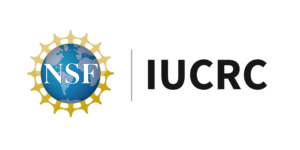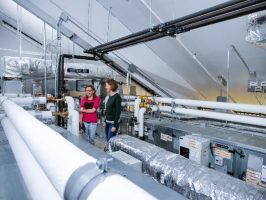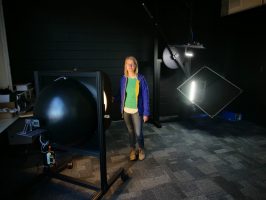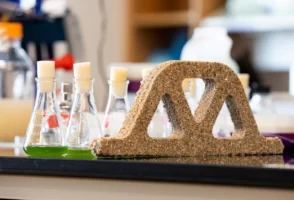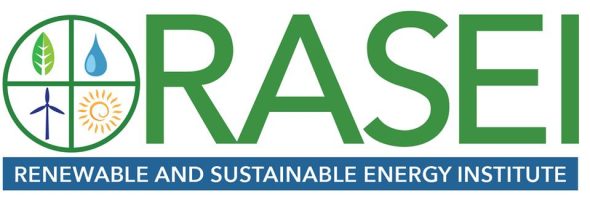Research
Research Capabilities and Projects
Labs and Groups
University of Colorado Boulder (CU)
GRIFFIN Lab (Baker)
Solar Cells & Dynamic Windows Lab (McGehee)
City College of New York (CCNY)
Building Performance Lab (Berk, Prahl, Bobker)
Smart Grid Interdependencies Lab (Mohamed)
Coastal Urban Environmental Research Group (Gonzalez-Cruz)
Projects
Funded Projects 2023-2024
Research Team: Jorge Gonzalez-Cruz (UAlbany), Prathap Ramamurthy (CCNY)
Major cities are rapidly evolving towards zero carbon emissions. This is the case of New York City (NYC) which has pledged via policy to the goal to achieve 80% carbon reduction by the year 2050, versus the benchmarked value in 2014 under Local Law 97. New York State’s clean energy objectives also include the Climate Leadership and Community Protection Act’s (“CLCPA”) which has an equally ambitious goal of reducing greenhouse gas (“GHG”) emissions by 85 percent from 1990 levels by 2050. The existing carbon emission scenario for NYC is 52 metric tons of carbon dioxide equivalent (MTCO2e). These emissions are dominated by the building sector (69%), followed by transportation (27%), and waste (4%). This challenge presents an opportunity to introduce new electrically driven HVAC systems for the building sector for major cities across the US. A large portion of the buildings’ emissions in NYC is related to seasonal winter heating and hot water via the use of natural gas. In order to achieve the projected goals, a deep electrification of the heating systems will be required, with electricity to come from solar PV, wind, and hydro from within and outside the city.
This project is a partnership with the City of New York and the HVAC industry to further develop, test, and demonstrate advanced low Global Warming Potential (GWP) air source electrical heat pumps (ASHPs) for hot water and space heating. Of particular emphasis for electrification of space heating are 1-4 Family Residential units, and large multifamily buildings (>5 Residential Units) which represents 35% of the building stock in NYC, or roughly 15,000 buildings of NYC, totaling approximately 1.35 Billion ft2. The majority of these buildings (more than 85%) are heated by natural gas systems installed in the 1980’s or earlier. The primary objective of the proposed research is to assess the technical and economic feasibility of retrofitting existing gas systems by a conventional refrigerant (R410a) and new Trans-critical (TR) -CO2 air source Heat Pump systems for climates such as those of NYC. R410a units are readily available in the markets for space heating, while TR-CO2 cycle is an emerging technology that has the enormous advantage of introducing low GWP (GWP=1) into the electrified markets.
The use of TR-CO2 promises simplicity in configuring the cycle and high thermal efficiency benefits which, combined with reduced size of turbomachinery components have the potential of significantly reducing the cost of construction and maintenance of heat pumps systems. These benefits are due to sharp property variations of TR-CO2 near its critical point where the sharp increase in density reduces the work of compression while increasing the efficiency.
Research Team: Moncef Krarti (CUB), James Zarske (CU), Duncan Prahl (CCNY)
Several cities are mandating that their building stocks be electrified to achieve preset decarbonization targets. For instance, New York City needs to decarbonize all of its buildings, including over 2 million dwellings by 2050. Preliminary practical experiences with electrification of existing buildings have indicated some prevalent challenges of properly retrofitting existing heating systems with heat pumps. Heat pumps are often oversized in several retrofits, sometimes by more than double, due to lack of any sound design analysis. This is especially true when heating electrification is coupled with other building envelope retrofit measures such as adding thermal insulation, weatherstripping, and replacement of windows. Noted issues with oversizing heat pumps include poor indoor thermal comfort due to uneven temperature fluctuations in addition to unnecessary high retrofit costs. Additionaly, the limited available electrical power capacities prevent the electrification of some existing dwellings without other mitigation measures. This project aims at the development of a tool that assists professionals in accurately sizing heat pumps and selecting other measures to properly electrify residential buildings based on automated calibration of “white-box” energy models.
The proposed project is to demonstrate and scale-up the application of a self-tuned, robust, and efficient energy analysis tool to automatically develop and calibrate detailed energy models in order to perform optimized retrofit analysis including selection of heating and cooling systems as well as domestic hot water appliances required to electrify existing residential buildings. Most modelers rely on manual and iterative calibration approaches to refine initial input parameters using some knowledge about the building design and operation. In doing so, they are often relying on their experience and expertise. Other methods use evidence-based approaches relying on detailed data obtained from reliable sources including as-built documents and field measurements. Automated calibration approaches use optimization and statistical methods to identify the input parameters of building energy models to minimize the difference between measured and simulated data. The proposed tool utilizes Bayesian-based parameter identification approach to calibrate energy model specific to any existing building using measured data.
Automatic calibration of building energy models remains challenging with limited available tools to perform this task efficiently. For instance, the autotune methodology developed by Oak Ridge National Laboratory (ORNL) used machine learning agents to search through millions of EnergyPlus simulations carried out using several supercomputers. This methodology is time consuming and may not be practical since building technologies are continuously evolving, and new energy systems are introduced. The proposed analysis tool is based on an efficient and proven calibration approach and readily used to determine the optimal package of energy efficiency actions and heat pump systems to electrify dwellings to meet desired targets and meet a set of constraints.
Research Team: John Zhai (CU), Robert Tenent (NREL)
The building sector is responsible for 40% of total energy consumption and more than 35% of greenhouse gas emissions in the US. The building envelope is the main thermal barrier between the indoor and outdoor environments and includes the walls, windows, roof, and foundation. The building envelope is a weak point of overall building consumption and is vital for improving building performance. Windows not only have a high U-factor compared to opaque envelope components, but also have solar gains that contribute to their overall heat transfer into spaces (solar heat gain coefficient). It is estimated that the building envelope makes up 30% of energy consumption for residential and commercial buildings with windows accounting for 15–50% of total envelope transmission losses and 10% of total energy consumption of buildings. However, the thermal performance of the envelope is not static over a building’s lifetime; it decreases with age and weathering, leading to higher energy requirements. The lifespan of a window is typically 30-40 years shorter than that of the overall building due to multiple modes of degradation including solar radiation, temperature fluctuation, wind pressure, water vapor, and oxygen/ozone exposure.
Although window and Insulated Glass Unit (IGU) degradation has been studied extensively, there is limited understanding of how present durability evaluation standards relate to product lifetime and performance. Further, there is debate on how to quantify performance of installed windows over time. More knowledge on these topics is required to link durability evaluation to product lifetime projections based on energy performance. Energy models can provide helpful estimations of total annual building energy consumption, however, most models are based on “as installed” performance of envelope components and fail to account for performance degradation, leading to an underestimation of building lifetime energy consumption and peak load demand. A better understanding of the relationship between durability and energy performance can inform integration of degradation dynamics into energy modeling software, improving lifetime building energy consumption estimations and informing retrofit strategies.
This Year-2 project will expand on our Year-1 study that focuses on comparing lab test methods and developing in-situ test protocols to conduct field tests on NREL and CU buildings with various window ages and properties for a systematical evaluation and improvement of identified field test methods. Correlations between window durability and thermal performance will be developed and improved upon using the test data, with which the energy impacts of window degradation will be quantified for different buildings in various climates. Figure 2 illustrates the potential energy impacts of extreme window degradation conditions predicted by Year-1 study. This new project will further demonstrate the feasibility of the identified field-testing methods for measuring the actual performance of IGUs under various operating and weather conditions.
Research Team: Moncef Krarti (CU), Ravi Kishore (NREL)
Several innovative measures have been proposed to reduce the energy consumption and improve the indoor air quality of buildings, including dynamic building envelope panels to enhance free ventilation, cooling, and heating strategies. Among the most promising dynamic panels include thermal energy storage (TES) systems such as phase change materials (PCMs) and switchable insulation systems. Switchable insulation provides the ability to modulate R-value of building envelope depending on the indoor and outdoor conditions. Switchable insulation systems can significantly reduce energy consumption in residential and commercial buildings. When integrated with PCM, the dynamic walls can provide 2-3 times higher energy savings than the walls integrated with only PCM or static insulation. Preliminary modeling analysis for both residential and commercial buildings showed that dynamic envelopes with PCM can reduce wall-related cooling load by up to 72% and heat load by up to 38%.
As part of the on-going efforts to electrify buildings, heat pumps are being installed in both new and existing buildings to replace fossil-fuel based heating systems. However, heat pumps are often supplemented with electrical resistance systems in cold climates. In addition to its inherent inefficiency, electrical resistance results in higher peak demand especially in extreme cold events when power generation capacities such as those from renewable technologies are limited. Thermal energy storage (TES) can alleviate the challenges of deploying heat pumps in cold climates including ice buildup and high peak demands while allowing shifting of heating as well as cooling loads and integrating renewable energy resources, thereby making the transition to electrification and decarbonization feasible and more cost-effective. There are no commercially available prefabricated panels that integrate both TES systems and heat pumps.
In this project, novel TES integrated panels that can be readily connected to new or existing heat pumps are to be prototyped for initial evaluation using laboratory testing and simulation analysis. The panels can be integrated as plug-in envelope systems for new and existing buildings equipped with heat pumps and storage systems. Moreover, the proposed TES-panels permit preheating of supply air to improve the energy efficiency of heat pumps while charging available storage media to be used to for either the space heating or domestic hot water. Moreover, the panels can be coupled with either solar air collectors or photovoltaic (PV) systems for increased thermal and electricity generation and storage capabilities. The proposed TES-panels can be easily installed in walls or roofs to improve the energy efficiency of the building envelope and heat pumps, as well as store heating and cooling energy to allow full use of renewable energy resources. The proposed system offers low-cost solution to enhance grid-efficient interactive building features including energy efficiency, flexible peak demand, and occupants’ thermal comfort.
Research Team: John Zhai (CU), Robert Tenent (NREL), Kosol Kiatreungwattana (NREL)
The contribution of windows to energy demand for heating and cooling buildings can be significant, especially for existing buildings with single pane glazing and high fenestration coverage. Fenestration systems are estimated to account directly for 10% of the primary energy used by US buildings. Replacing existing windows as part of retrofitting buildings presents several challenges including being cost-ineffective, time consuming, and disruptive to occupants. Secondary windows provide retrofit alternatives to improve the energy performance of existing fenestration systems. These devices essentially function as an “interior storm window” and consist of at least one glass pane installed in a framing unit that can be applied to the inside surface of an existing installation. Secondary windows can be easily added to the existing fenestration systems with the potential to reduce heat transmission and air infiltration as well as noise, at a minimal cost and minimal disruption for occupants. Studies show that the addition of four secondary-glazing products – plastic film, magnetically attached plastic sheet, plain and low-E glass to a single-glazed aluminum window can provide significant thermal improvements to the single-glazed window (0.15 m2-K/W), with R-values from 0.34 to 0.57 m2-K/W [2].
Limited analyses have been carried out to assess the energy and cost benefits of secondary windows. The addition of the secondary glazing product can carry with it the potential risk of condensation in the air cavity between the existing installation and the new product. In the US, very few studies have been conducted on secondary windows revealing some energy efficiency potential but also high condensation risks. A recent hybrid field testing and simulation-based study evaluated the thermal, energy, and cost benefits of 10 secondary windows installed in an office building in Denver, CO. The results of the study indicated that double-pane secondary windows can save 40% of heating, ventilating, and air conditioning (HVAC) energy end-use, 19% of heating capacity, and 13% of cooling capacity. However, the study indicated that secondary windows, both single-pane and double-pane, have condensation risks with condensation resistance ranging from 44 to 46, below the desired rating of 50.
This project will include systematic laboratory testing coupled with a detailed simulation analysis to evaluate the energy efficiency and condensation risks for secondary windows as well as establish a clear set of recommendations for their suitability and cost benefits for various building types and climate zones.
Research Team: Gregor Henze (CUB)
Currently, building automation and control is a costly, labor- and engineering-intensive procurement process, which often leads to suboptimal and rigid energy management systems that lack the ability to adapt and respond to changes of any internal and external conditions. Worse, our built environment as an industry is often viewed critically as being static, innovation-resistant, and risk adverse. Reinforcement learning (RL) as a data-driven optimization technique has gained significant attention recently due to its success in autonomous vehicles, robotics, recommendation systems, and natural language processing. This success has attracted the attention of the building automation and controls field due to its potential application to both residential and commercial buildings to optimize complex multi-objective performance goals of occupant comfort, energy efficiency, carbon emissions, and the provision of grid flexibility. However, RL control (RLC) has several drawbacks in its application to building control problems as they may require large training times as well as unpredictable behavior in the initial stages of learning. The first phase of this project has successfully shown that approaches such as imitation learning and inverse RL can address these implementation hurdles. This project aims to make RL applications to building control problems practical for real-world implementation in a new and promising direction, i.e., to harness feedback offered by humans such as building occupants and operators.
Human-in-the-loop (HIL) RL is one the emerging topics in the artificial intelligence community leveraging human intelligence in the training loop to improve the efficiency and performance of the AI agent in complex environmental scenarios. It is particularly useful in domains where unexpected erroneous control behavior, as a result of exploration, can possibly have severe consequences in real world scenarios. In the building controls domain, HITL RL may prove to be particularly useful as the RL agent would give preference to previously developed conventional operating strategies and the needs of building occupants. It is expected that effective control solutions are found that satisfy a wide range of occupants, achieved by considering their expressed preferences on indoor environmental conditions such as thermal comfort, indoor air quality, visual comfort, or acoustic conditions, while optimizing for factors such as energy consumption, demand management, and other user needs (e.g., EV charge scheduling). The goal of this research is to investigate the benefits of utilizing HITL RL as a solution to optimally balance the multiple and often conflicting operational objectives in the management of commercial buildings, addressing real-world challenges and opportunities related to renewable energy sources, harnessing buildings as flexible grid system participants and electric vehicles (EVs) as energy storage devices. The research aims to develop a scalable and data-driven control framework that can reconcile these various conflicting control objectives.
Funded Projects 2022-2023
Research Team: John Zhai (CUB), Robert Tenent (NREL)
Little is understood about how building performance degrades over time. Degradation leads to decreased environmental quality which can impact underserved communities. Better understanding this area will help determine the root cause for performance loss and define how retrofit technologies may be best employed. Window performance is believed to degrade more quickly than other building components and hence provide an excellent test technology for developing methods to assess building performance loss over time. This project will evaluate multiple methods to characterize installed windows. The goal of the proposed research is to compare current window performance measurement methods and establish which is most accurate and accessible for in-field use.
Peer-Reviewed Paper: Degradation of Insulating Glass Units: Thermal Performance, Measurements and Energy Impacts
Download (pdf)
Research Team: Moncef Krarti (CUB), Kyri Baker (CUB), Xin Jin (NREL)
This project aims to develop a platform for simultaneously operating heat pumps and water heaters with and without rooftop photovoltaics (PV) and battery storage to enhance energy efficiency and demand response capabilities of electrified residential buildings. The proposed platform can accommodate any combination of heating/cooling and water heating systems as well as be integrated in existing energy management systems. The proposed platform consists of three modules, RC-based model for the building to estimate the heating/cooling loads as well as indoor conditions including thermal comfort, separate modules for each device to control including for this project a heat pump and a water heat, and a model-predictive controller to generate specific optimized actions for all the devices to be controlled. The project will have three main phases. Phase I includes (i) refining and calibrating a previously developed RC-model using data from existing homes, (ii) developing algorithms for model predictive controller with its load and weather prediction schemes, and (iii) establishing performance modules of heat pump and water heater using either physical but simplified models or data-driven models based on manufacturer’s data. Phase II consists of performing a series of analyses to assess the benefits of combined controls for the heat pump and water heater with and without storage devices for various equipment types, occupant thermal comfort preferences, utility rates, and climate conditions. It is expected that simplified rule-based control sequences will be developed based on the results of the optimization analyses. Phase III involves writing of a final report and a technical paper to disseminate the results of the project analysis approach and findings.
Research Team: Honey Perk (CCNY) and Duncan F Prahl (CCNY)
The project will develop and test methods for the automated/semi-automated Measurement and Verification (M&V) of avoided energy and carbon emission reductions using Option D (Calibrated Simulation) per the International Performance Measurement and Verification Protocol (IPMVP), the internationally recognized standard for energy M&V practice. Workflows associated with automated extraction and/or generation of site-specific building energy models (BEM) will be developed for a sample ofsites drawn from the NYC municipal property portfolio. This work seeks to build on prior efforts such as the SimStadt model, NREL’s URBANopt, and similar work being undertaken at Concordia University in Montreal. It is anticipated that the base data for these models will be derived from NYC Open Data datasets such as the NYC CityGML 3D model of City facilities, building energy audit data collected in compliance with NYC Local Law (LL) 87, and benchmarking and utility data collected in compliance with LL84.Where possible, BAS trend data will also supplement model development. Open source calibration methods using monthly, daily, hourly, or 15-minute interval energy data will be applied to the models, using actual energy data available through utility APIs or the building energy information system used by the NYC DCAS Division of Energy Management. A subset of the resulting models will be evaluated against proposed and implemented energy conservation/carbon reduction measures (ECMs), comparing initial audit recommendations, detailed energy engineering analysis from the project development phase, and the estimated avoided energy from implemented projects. Once tested and demonstrated, the workflow will be ready for coding for automated or semi-automated operations (likely using Python) at the portfolio scale. This coding may be continued during a subsequent phase of the project. The goal is to develop a simplified workflow to generate a library of geometry and equipment-specific BEM for portfolios of buildings that can be used to evaluate ECMs at scale and in compliance with IPMVP Option D.
Research Team: Prathap Ramamurthy (CCNY)
The project intends to develop a multi-scale energy forecasting system using satellite data. The project will use thermal inertia of the built environment, calculated from satellite data to forecast energy usage at building to city scale. Energy use in cities is directly correlated to heat stored in the environment and the incident weather conditions. Current state of the art satellites are able to predict energy storage in the built environment at hourly time scales. This information can be used to project energy usage at various spatial scales. Compared to traditional methods that are computationally expensive and or need expert supervision, this method will use publicly available data that can be used to both forecast and now cast energy use at variousspatial scales. The project also has potential to understand how the built environment contributes to energy use and what changes can be done to improve energy efficiency. We will use data from GOES-16 satellite to compute the hourly energy storage-this data is available for the entire continental US. We will downscale the data using ancillary satellite measurements. This data will then be correlated/trained with high resolution land use map (including building level data) and projected building energy data from numerical modeling using artificial intelligence (AI) algorithms. The outcome will be an AI model that will use publicly available satellite data as input to forecast energy use. New York City will be used a test case to train the model. The outcome will be able to function in any urban environment in the US.
Research Team: Moncef Krarti (CUB), Shawhin Roudbari (CUB)
The project explores flexible and easy-to-install insulated panels suitable for retrofitting exterior walls, roofs, and windows for existing residential buildings with minimal disturbances to homeowners and occupants. The insulated panels can be prefabricated to fit the need and geometry for individual building and envelope elements, including wiring for outdoor lighting and fittings for water drainage. These panels can be easily installed using sliding rails to secure them along the outdoor surfaces of the existing building envelope systems. Moreover, the panels can be suitable as insulated shading devices that can be dynamically operated to adjust both solar gains and thermal transfer for the windows. Finally, the panels can be integrated with fixed or adjustable PV panels for on-site renewable power generation. A preliminary analysis of the insulated panels has shown that they can improve the energy performance of any existing windows and can save up to 50% of the annual energy demand for an apartment unit located in Boulder, CO. The project has three major tasks including: (i) Developing architectural features of the insulated panels including the railing systems and connections between panels using various architectural visualization techniques such as animations and 3-D renderings. (ii) Testing a basic prototype in the laboratory to determine their energy performance when attached to an existing wall using the existing experimental set-up available with the Larson HVAC laboratory at University of Colorado Boulder, and (iii) Performing modeling-based analysis to assess the energy performance of the insulated panels for existing residential buildings located in representative US climates.
Research Team: Gregor Henze (CUB), Sourav Dey (CUB)
Reinforcement learning (RL) has gained significant traction recently due to its success in autonomous vehicles, robotics, and gaming industries learning through interaction without developing any complex models. This has attracted the attention of the building automation and controls field due to its potential application to residential and commercial buildings to optimize complex multi-objective cost functions, balancing multiple goals of occupant comfort, energy efficiency, carbon emissions, and grid flexibility in place of rule-based or heuristic controls. However, RL control has several drawbacks in building control applications. They may require significant training times, possibly on the scale of years’ worth of interaction to learn a near-optimal solution and early unstable training behavior, making it unrealistic to be applied directly to building control tasks. This research aims to address these issues with the assistance of surrogate models and transfer learning techniques to improve the scalability of RL control applications, providing recommendations for field deployment. The project’s contribution is to advance the knowledge of practical RL applications in building controls where there is currently a lack of advanced controls with yet unrealized potential for saving energy, providing superior thermal comfort and indoor air quality, increasing workspace productivity, and providing electric.

